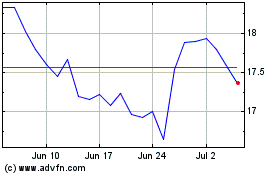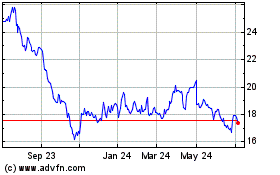Canadian Carriers Appear Set to Join U.S. Air-Safety Program
August 25 2016 - 5:50PM
Dow Jones News
WASHINGTON—U.S. airlines and aviation regulators are poised to
break new ground by expanding voluntary safety-reporting efforts to
include data from Canadian carriers, according to people familiar
with the discussions.
If the talks succeed, these people said, incident reports from
Air Canada and two other large Canadian carriers would begin to be
combined with extensive voluntary safety reports already being
collected from U.S. pilots, cabin crews, air-traffic controllers,
mechanics and other domestic sources.
No foreign data has ever been incorporated into the signature
U.S. safety-data collection and analysis effort, which is known by
the acronym Asias, for Aviation Safety Information Analysis and
Sharing system.
The goal, according to these people and other industry experts,
is to reveal new air-safety threats or operational risks by
assembling a more complete picture of incipient hazards and
potentially dangerous trends spanning both sides of the border.
Launched in the late 1990s, such joint industry-government
initiatives are the principal building blocks of record U.S.
airline safety statistics that have avoided any passenger
fatalities since early 2009. "That is an amazing accomplishment,"
Peggy Gilligan, the U.S. Federal Aviation Administration's top
safety official, told a safety conference here Wednesday, adding
that Asias is a big reason.
A final decision on Canadian involvement hasn't been made, and
the initiative to incorporate data from Air Canada, along with
carriers WestJet Airlines Ltd. and Jazz Aviation LP, still could
falter. But active discussions among all sides are under way,
according to several people familiar with the details, and within
the past year Canadian regulators wrote a letter to the FAA
supporting the concept. Prospective cross-border cooperation was a
topic of public and private discussion during the pilot
union-sponsored conference that ended Thursday.
After on-again, off-again talks during the past year or two, a
Canadian agreement could come together as soon as several weeks
from now, according to people involved in the process. Others
predicted it's likely to take months.
One major issue still awaiting resolution, however, deals with
legal protections for U.S. data under Canada's legal and regulatory
systems. In the U.S. voluntary safety data is protected from
disclosure to the press, can't be used as part of civil lawsuits
and is kept even from federal safety inspectors who might use it in
enforcement cases.
More than 40 U.S. airlines currently participate in the
industrywide Asias program, along with more than two dozen
corporate and fractional-jet operators. But proponents have long
felt that incorporating data from the three big Canadian
carriers—which would encompass some hub airports and busy North
Atlantic routes—could broaden the program's scope and possibly
reveal dangers or patterns that may have been missed or somehow
overlooked. In the past, a few European carriers have tried to join
Asias but ultimately failed to clear the logistical and legal
hurdles.
There are roughly 70 million flight annually in U.S. airspace, a
total that includes airlines, business aircraft and private planes.
The comparable figure is about 12 million for Canada, which is
responsible for providing safe navigation and various other
services to pilots across the second-largest chunk of
controller-supervised airspace in the world, after the U.S.
The same trend is evident in other parts of the world. European
air-safety regulators and many of the airlines they oversee are
moving to set up their own regional data-sharing program, patterned
largely after Asias. Separately, Singapore government officials and
the nonprofit advocacy group Flight Safety Foundation, in
conjunction with Mitre Corp., a federally funded research
organization, have taken steps to set up a data analysis program
serving that part of the globe.
Asias started with just four U.S. carriers but expanded
dramatically as airline officials recognized its value, and
increasingly trusted the FAA and Mitre, the agency's contractor, to
maintain the confidentiality of the information. It is now the
world's largest repository of air-safety data.
Today, the Asias database includes detailed records of some 20
million flights across U.S. airspace; roughly 200,000 incident
reports voluntarily submitted by pilots; and roughly 100,000
voluntary reports from traffic controllers. On average, pilots file
about 4,300 fresh reports each month.
Analyzing such a high volume of information can pose challenges,
including delays in uncovering underlying patterns. But the
potential benefits are equally large, safety experts said, because
the technique provides the best chance to identify needed safety
enhances before accidents occur.
Corrections & Amplifications: U.S. airline safety statistics
have avoided any passenger fatalities since early 2009. An earlier
version of this article incorrectly stated there haven't been any
passenger fatalities since early 2008.
Write to Andy Pasztor at andy.pasztor@wsj.com
(END) Dow Jones Newswires
August 25, 2016 17:35 ET (21:35 GMT)
Copyright (c) 2016 Dow Jones & Company, Inc.
Air Canada (TSX:AC)
Historical Stock Chart
From Mar 2024 to Apr 2024

Air Canada (TSX:AC)
Historical Stock Chart
From Apr 2023 to Apr 2024
